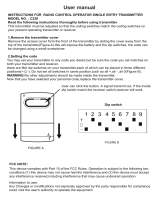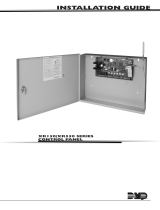Page is loading ...

Model
: TX3-CX-REC
Mircom
Canada U.S.A
25 Interchange Way 4575 Witmer Industrial Estates
Vaughan, ON L4K 5W3 Niagara Falls, NY 14305
Tel: (888) 660-4655 Tel: (888) 660-4655
(905) 660-4655 (905) 660-4655
Fax: (888) 660-4113 Fax: (888) 660-4113
(888) 660-4113
Page 1 of 4
LT-990 Version 1.00.1
S1 – Data Path Selector
WIEGAND RECEIVER INSTALLATION INSTRUCTIONS
INTRODUCTION
The Model TX3-CX-REC Wiegand Receiver unit is designed to interface with the access control
panel’s card reader port using the Wiegand protocol. The unit receives the ID credentials from the key
tag transmitters, which consists of a site and ID number.
Several receiver options can be set by the jumper settings on the unit. The receiver sends the
information to the control panel in a Wiegand bit format. Transmitter buttons on a multi-button
transmitter can be selectively chosen from one to four by setting the switches on the S1 Data Path
Selector switch.
TABLE OF CONTENTS
Unpacking
Selecting mounting location
Power Supply and grounding
Installation
Wiring Diagram - Typical
Wiring Diagram – Two receivers
UNPACKING
The receiver unit contains all the intelligence to provide reliable long-range wireless access control
from a gate or over-head door. Each unit is packed with four enclosure fastening screws. Mounting
hardware is not provided.
Receiver Settings
JP5 5-volt option
Removable Terminal
Block
Connect AWG #22 to 14
sized wires to the terminal
block.

Model
: TX3-CX-REC
Page 2 of 4
LT-990 Version 1.00.1
SELECTING MOUNTING LOCATION
Radio frequency (RF) is one of the most useful tools in security technology today. It has evolved
generations past the technology that has given us radios, remote control garage doors, televisions and
remote-controlled model airplanes. Although modern security applications focus on sophisticated
coding systems, scientific principles as old as the radio still apply.
In the very early days of garage door openers, around the 1950s, the transmitters were extremely
simple. They sent out a single signal, and the garage door opener responded by opening or closing.
As garage door openers became common, the simplicity of this system created a big problem --
anyone could drive down the street with a transmitter and open any garage door! They all used the
same frequency and there was no security encryption.
The TX-P2-0/TX-P2P-0
transmitter is not like a garage door opener. You can see this level of
sophistication on the transmitter, as it has no DIP switches to copy another transmitter code. To
combat the
proliferation of code grabbers, you also need to prevent people from "capturing" the code
that your transmitter sends. Once they have your code, they can simply re-transmit it to gain
unauthorized entry. The TX-P2-0/TX-P2P-0
uses
incremental packet transmission so each code
transmission is different each time the button is pressed to prevent code grabbers from circumventing
a security system.
The receiver unit must be able to get a strong enough signal to verify the signal originated from a
transmitter.
Non-metallic
material -
eg. wood
Minumum four
(4) inches
from wall
Wall
Receiver
Wall Mounted
Ceiling
Ceiling Mounted
Receiver
L-Bracket
DO NOT
mount receiver and antenna near
any source of interference (i.e. Proximity Card
Readers, other RF receivers, motors, etc) or
metal structures (i.e. pipes). The greater the
height and distance between the antenna and
the source of interference the better. A
minimum of 2.4 meters (8 feet) is
recommended. Installing antennas too close
to the electrical source can affect
performance.
Antennas should be mounted as far away
from the ceiling or wall as possible – a
minimum of 10 centimeters (4 inches). For
maximum range, mount antennas vertically,
as high as possible and in view. The location
should offer protection from vandals.
The receiver unit can also be mounted flush
with a wall or ceiling if the antenna is remotely
connected with a coaxial patch cord and
mounted 10 centimeters (4 inches) from the
wall or ceiling surface. Limit the length of the
50-ohm coaxial cable [RG-11U] to less than
4.5 meters (15 feet) and use weatherproof F-
connectors if mounting the cable outside.
Water droplets accumulating inside an F-
connector will short out the cable. For best
performance, mount the antenna vertically.

Model
: TX3-CX-REC
Page 3 of 4
LT-990 Version 1.00.1
POWER SUPPLY AND GROUNDING
Power requirements: 12-24 VDC, 50 mA (stand-by), 100mA (peak).
A linear type power supply is recommended if a separate power supply is used. If the unit is to be
powered by 5 VDC, jumper across JP5 pads. Proper grounding gives an electrical charge, like an
electrical static discharge or a near lightning strike, a path from which to dissipate its energy safely into
the earth. It is strongly recommended to connect an earth ground wire to each receiver unit. (Note 2).
INSTALLATION
Data Path Selector Settings:
The receiver unit conveniently provides for field selectable switches S1 located near the center of the
board. By changing the ON or OFF position on the S1 DIP switch, determines which specific button on
the TX-P2-0/TX-P2P-0
multi-button transmitter will activate the receiver and Wiegand format to be
transmitted to the control panel.
S2
S2
S2
S2
When global coverage of a large area is
required, there should be a sufficient number of
receivers to give overlapping coverage of
receiving patterns.
Use the SW terminal if the receiver antennas
are less than 30.5 meters (100 feet) apart. The
SW terminal connection prevents data clash at
the control panel. See Note 3.
LED Indicators:
(Y4) – Flashes when the transmitter code is valid.
(Y5) – Flashes if the transmitter encryption code does not match the receiver and will not operate the receiver. Check the
transmitters are programmed to operate with this receiver.
(Y6) – Power on indicator and RF activity indicator. The LED will flicker to indicate the receiver has power. If the LED
remains on steady, there is a continuous 433 MHz signal that will prevent the unit from operating reliably.
(Y8) – Controlled externally by the access control panel. Typically this is controlled by the access control panels LED
confirmation output (Brown wire).
Wiring
12 VDC
Maximum distance AWG #
152 m (500 feet) 18
112 m (369 feet) 20
76 m (248 feet) 22
Receiver Relay:
The receiver relay activates for one second when a transmitter is
triggered. The relay on the receiver can be used for testing purposes by
adding an audible or visual device to confirm the receiver is receiving the
signal consistently from the desired location of the transmitters. Only when
the relay is triggered will the Wiegand output send the ID credentials of the
transmitter pendant.

Model
: TX3-CX-REC
Page 4 of 4
LT-990 Version 1.00.1
Data 0
Data 1
SW -
LED
SW +
C
NO
NC
COM
Data 0
Data 1
SW -
LED
SW +
C
NO
NC
COM
Receiver
(Optional)
Red
Black
Data 0
Data 1
SW -
LED
SW +
C
NO
NC
COM
Card Access
Control Panel
Brown
Green
White
(Optional)
Red
Black
Card Access
Control Panel
Brown
Green
White
Note: This equipment has been tested and found to comply with the limits for a Class B digital device, pursuant to part 15 of the
FCC Rules. These limits are designed to provide reasonable protection against harmful interference in a residential installation. This
equipment generates, uses and can radiate radio frequency energy and, if not installed and used in accordance with the instructions,
may cause harmful interference to radio communications. However, there is no guarantee that interference will not occur in a
particular installation. If this equipment does cause harmful interference to radio or television reception, which can be determined by
turning the equipment off and on, the user is encouraged to try to correct the interference by one of more of the following measures:
• Reorient or relocate the receiving antenna.
• Increase the separation between the equipment and receiver.
• Connect the equipment into an outlet on a circuit different from that to which the receiver is connected.
• Consult the dealer or an experienced radio/TV technician for help.
This device complies with part 15 of the FCC rules. Operation is subject to the following two conditions:
1. This device may not cause harmful interference, and
2. This device must accept any interference received, including interference that may cause undesired operation.
/

